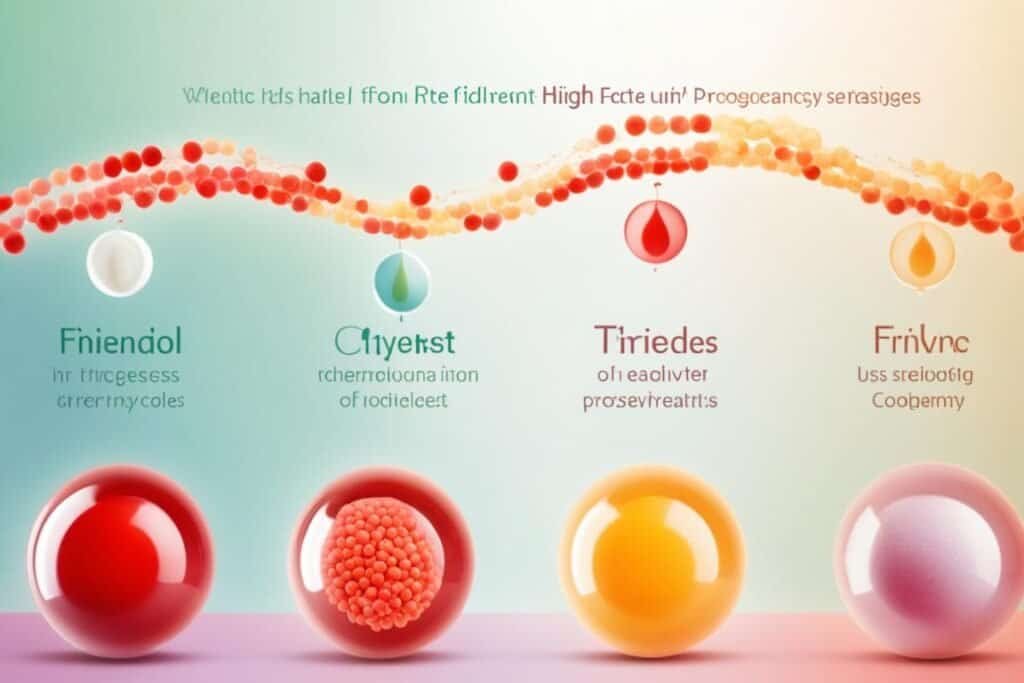If you’re pregnant or planning to become pregnant, it’s essential to understand the implications of high triglyceride levels during pregnancy. Triglycerides, a type of fat in your blood, naturally increase during pregnancy to support the growth and development of your baby. Cholesterol levels, another type of fat, also rise during pregnancy to produce hormones vital for the pregnancy. However, it’s important to note that checking cholesterol and triglyceride levels during pregnancy may not provide accurate information and can potentially cause unnecessary worry.
For women with high cholesterol levels before pregnancy, the increase in cholesterol during pregnancy may be more significant. However, the rise does not pose any risk to you or your baby. In rare cases, women with very high triglyceride levels before pregnancy may develop severely raised triglycerides, which can lead to complications like acute pancreatitis.
If you have a condition called familial hypercholesterolaemia (FH) and are pregnant or planning to get pregnant, it’s crucial to seek the care of specialists who can assess your risk of heart disease and monitor your condition. Certain cholesterol-lowering medications, such as statins and ezetimibe, should be stopped during pregnancy as they can potentially harm the baby. However, these medications can be safely resumed after the baby is weaned off breast milk.
It is recommended to wait at least six to eight weeks after giving birth before having a cholesterol test. This is because blood cholesterol and triglyceride levels tend to stay elevated for some time after delivery.
Key Takeaways
- Triglyceride levels naturally rise during pregnancy to support the baby’s growth and development.
- Checking cholesterol and triglyceride levels during pregnancy may not reflect normal levels and can cause unnecessary worry.
- High triglyceride levels before pregnancy can lead to complications like acute pancreatitis.
- If you have familial hypercholesterolaemia (FH), specialists can assess your risk and monitor your condition during pregnancy.
- Cholesterol-lowering medications should be stopped during pregnancy but can be resumed after breastfeeding.
Physiology and Importance of Lipids in Fetal Development
During pregnancy, the role of lipids, including cholesterol and essential fatty acids, is crucial for the proper development of the fetus. Cholesterol plays a significant role in the formation of cell membranes and is essential for the normal growth and function of fetal tissues.
Not only is cholesterol necessary for the structural integrity of cells, but it also acts as a precursor for the production of vital hormones. These hormones, in turn, play a key role in regulating various physiological processes necessary for a healthy pregnancy.
The fetus obtains cholesterol from both endogenous and exogenous sources. Endogenous cholesterol refers to cholesterol produced by the fetus itself. On the other hand, exogenous cholesterol is derived from the mother’s circulation and is transferred to the fetus through the placenta.
The placenta, the organ responsible for fetal nourishment and waste removal, plays a vital role in the transfer of lipids, including cholesterol, from the mother to the developing fetus.
In fetal circulation, high-density lipoprotein (HDL) serves as the primary carrier of cholesterol. HDL helps transport cholesterol to the developing organs and tissues, ensuring their proper growth and function.
Abnormal lipid metabolism, such as dyslipidemia, can have significant implications for pregnancy outcomes and long-term health. Imbalances in lipid levels during pregnancy have been associated with conditions like preeclampsia and birthing large-for-gestational-age (LGA) infants.
Insert image here:

Changes in Lipid Profiles During Pregnancy
During pregnancy, your lipid profiles undergo significant changes to support the growth and development of your baby. Understanding these changes can help you better manage your health during this crucial time.
In a normal pregnancy, your total cholesterol levels increase by approximately 50%. This increase is primarily due to higher levels of low-density lipoprotein cholesterol (LDL-C), often referred to as “bad” cholesterol. LDL-C levels typically rise by 30-40% during pregnancy.
On the other hand, your high-density lipoprotein cholesterol (HDL-C) levels, also known as “good” cholesterol, increase by 25%. HDL-C plays a protective role by removing excess cholesterol from your bloodstream.
Triglycerides, a type of fat found in your blood, also experience substantial changes during pregnancy. Triglyceride levels increase by 2-3 times their normal values. This increase is necessary to provide adequate nutrients for the optimal growth and development of your baby.
These changes in lipid profiles occur throughout pregnancy and are influenced by increasing insulin resistance in your body. Insulin resistance is a natural physiological response that ensures a steady supply of nutrients to support your baby’s growth.
It’s important to note that these changes in lipid profiles are similar in both normal-weight and overweight or obese women. Regardless of your body mass index (BMI), your body undergoes these adaptations to meet the increased demands of pregnancy.
High Triglyceride Levels and Preterm Delivery
While mild to moderate increases in triglyceride levels during pregnancy are expected, high triglyceride levels during early pregnancy can pose certain risks. Research suggests that elevated triglyceride levels during the first trimester are associated with an increased risk of preterm delivery.
Preterm delivery refers to giving birth before 37 weeks of gestation. It poses potential health risks to both you and your baby. By understanding the relationship between high triglyceride levels and preterm delivery, healthcare providers can identify potential risk factors and develop strategies to prevent complicated pregnancies.
| Triglyceride Levels | Risk of Preterm Delivery |
|---|---|
| Normal Range | Negligible risk |
| Mild to Moderate Increase | Slight increase in risk |
| High Increase | Significant increase in risk |
Note: The risk of preterm delivery increases further with higher triglyceride levels during early pregnancy.
It’s important to work closely with your healthcare provider to monitor and manage your lipid profiles during pregnancy. Regular check-ups and appropriate interventions can help reduce the risks associated with high triglyceride levels.
Next, we’ll explore the association between high triglyceride levels and preterm delivery in more detail to gain a deeper understanding of the factors that influence pregnancy outcomes.
Association Between High Triglyceride Levels and Preterm Delivery
High triglyceride levels during early pregnancy have been found to be associated with an increased risk of preterm delivery. This association holds true for both overweight or obese women and those with a normal BMI.
Studies have shown that the risk of preterm delivery, particularly early preterm delivery, is higher in women with higher triglyceride levels during pregnancy. This highlights the importance of understanding the relationship between triglyceride levels and preterm delivery to identify potential risk factors and develop effective strategies for prevention and management.
Further research is needed to fully comprehend the implications of dyslipidemia in pregnancy on both maternal and fetal health. By gaining a deeper understanding of the underlying mechanisms, healthcare professionals can enhance their ability to predict, prevent, and manage preterm delivery more effectively.

| Key Points | Implications |
|---|---|
| High triglyceride levels in early pregnancy | Increased risk of preterm delivery |
| Both overweight/obese women and those with a normal BMI | Associated with higher risk |
| Focus on understanding the relationship | Identify risk factors and develop prevention strategies |
| Further research needed | Comprehend implications on maternal and fetal health |
Management of High Triglyceride Levels in Pregnancy
Managing high triglyceride levels during pregnancy is essential for ensuring a healthy pregnancy and minimizing potential risks. A multifaceted approach involving lifestyle modifications, medication considerations, and regular monitoring is recommended. Let’s explore the various aspects of managing high triglyceride levels in pregnancy.
Lifestyle Modifications
One of the key components of managing high triglyceride levels is adopting a healthy diet, engaging in regular exercise, and practicing weight management. Incorporating these lifestyle modifications can help regulate triglyceride levels and promote overall maternal well-being.
Diet: Your diet plays a crucial role in managing high triglyceride levels. Aim for a balanced and nutritious diet that includes:
- Fruits and vegetables
- Whole grains
- Lean proteins
- Healthy fats, such as those found in nuts, avocados, and olive oil
- Limited intake of sugary and processed foods
- Reduced consumption of saturated and trans fats
Consult with a registered dietitian or nutritionist for personalized dietary recommendations based on your specific needs and preferences.
Exercise: Engaging in moderate-intensity exercise, as recommended by your healthcare provider, can help improve triglyceride levels. Activities such as brisk walking, swimming, and prenatal yoga can be safe and beneficial during pregnancy. Remember to consult with your healthcare provider before starting or modifying any exercise routine.
Weight Management: Maintaining a healthy weight is important for managing triglyceride levels. If you are overweight or obese, your healthcare provider may provide guidance on appropriate weight management strategies during pregnancy. Strive for gradual and sustainable weight loss under the supervision of a healthcare professional.
Medication Considerations
It is crucial to be cautious with medication use during pregnancy to avoid potential risks to the baby. Several cholesterol-lowering drugs, such as statins and ezetimibe, are not recommended during pregnancy due to their potential harm to the developing fetus.
However, there are certain medications called bile acid sequestrants that can be prescribed during pregnancy and breastfeeding as they do not cross the placenta and pose minimal risks to the baby. This type of medication should only be initiated and monitored by a specialist, such as a lipidologist, cardiologist, or obstetrician.
Regular Monitoring
Close monitoring by healthcare specialists is essential for women with conditions like familial hypercholesterolaemia (FH) or other risk factors for heart disease. These specialists can assess your risk, screen for other complications, and provide appropriate guidance and treatment recommendations.
The timing of cholesterol and triglyceride level testing after giving birth should be determined based on individual circumstances, such as the presence of complications or surgery. It is generally recommended to wait six to eight weeks after giving birth to have a cholesterol test, as levels tend to stay elevated for some time postpartum.
Remember, individual treatment plans may vary, and it is important to consult with your healthcare provider for personalized advice and guidance based on your specific medical history and needs.
The management of high triglyceride levels in pregnancy requires a comprehensive approach, including lifestyle modifications, medication considerations, and regular monitoring by healthcare specialists. By implementing these strategies, you can take proactive steps towards a healthier pregnancy and reduce potential risks for both you and your baby.
| Treatment Options | Medication Risks |
|---|---|
| Bile acid sequestrants | Minimal risks to the baby, safe for use during pregnancy and breastfeeding under specialist supervision |
| Statins and ezetimibe | Not recommended during pregnancy, potential harm to the developing fetus |
Conclusion
High triglyceride levels during pregnancy can have significant implications for both maternal health and fetal development. It is important to understand that these elevated levels are associated with an increased risk of preterm delivery, particularly early preterm delivery. To ensure the best outcomes for both mother and baby, managing triglyceride levels during pregnancy is crucial.
Preventing high triglyceride levels can be achieved through lifestyle modifications, such as maintaining a healthy diet and engaging in regular exercise. These simple steps can go a long way in reducing the risks of prenatal complications. Regular monitoring by specialists, including lipidologists, cardiologists, and obstetricians, is also recommended to assess maternal health and screen for potential complications.
In addition, it is vital to avoid certain medications, such as cholesterol-lowering drugs, during pregnancy as they can potentially harm the baby. Instead, bile acid sequestrants can be prescribed during pregnancy and breastfeeding as they do not cross the placenta. These precautions, combined with individualized care and guidance, can help manage high triglyceride levels effectively.
As we continue our quest for better maternal and fetal health, future research should focus on further understanding the relationship between triglyceride levels and pregnancy outcomes. By identifying effective strategies for prevention and management, we can promote healthier pregnancies and contribute to the long-term well-being of both mothers and their precious babies.

